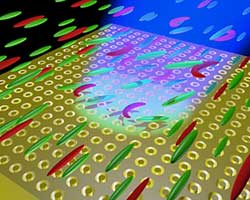Photonics: Think thin, think vibrant

Schematic of the tunable color filter. The combination of a gold film with ring-shaped holes and the use of liquid crystals (red and green) enables pixels of a defined color that can be turned on and off. © 2012 Y. J. Liu<br>
Flat panel displays, mobile phones and many digital devices require thin, efficient and low-cost light-emitters for applications. The pixels that make up the different colors on the display are typically wired to complex electronic circuits that control their operation.
Jing Hua Teng at the A*STAR Institute of Materials Research and Engineering and co-workers have now developed a display technology that requires a much simpler architecture for operation. They demonstrated that combining a thin perforated gold film with a liquid crystal layer is all that it takes to make an efficient color filter.
“Our color filters are a lot thinner and more compact than conventional thin-film-based color filters,” says Teng. “The colors of these filters can be tuned with ease so they are very versatile in applications.”
The color selection of the devices comes from the patterned gold film. The collective motions of the electrons on the film surface — the so-called surface plasmons — absorb light at wavelengths that depend on the details of these patterns. In the present case, the patterns are narrow, nanometer-sized rings cut out of the films (see image). As the diameter of the rings changes, so does the color of the metal film. Pixels of a different color can be realized simply by patterning rings of different sizes across the same gold film.
To realize a full display, however, each of these pixels needs to be turned on and off individually. This is where liquid crystals come in.
Liquid crystals are molecules that can be switched between two different states by external stimuli, such as ultraviolet light. In their normal state the crystals let visible light pass through so that the pixel is turned on. But when ultraviolet is also present, the structure of the liquid crystal molecules will change so that it absorbs visible light (i.e. the pixel is turned off). This process can be repeated over many cycles without degrading the device itself.
Although the device works in principle, it remains a concept on the drawing board for now. This is because there are still many issues that need to be overcome, for example, the optimization of the switching speed and the contrast between ‘on’ and ‘off’ states. In future work, the researchers will need to extend their ideas so that their device can serve a larger area and produce the fundamental colors red, green and blue.
Teng and his team are quite optimistic that they will achieve this soon.
The A*STAR-affiliated researchers contributing to this research are from the Institute of Materials Research and Engineering.
References:
Liu, Y. J., Si, G. Y., Leong, E. S. P., Xiang, N., Danner, A. J. & Teng, J. H. Light-driven plasmonic color filters by overlaying photoresponsive liquid crystals on gold annular aperture arrays. Advanced Materials 24, OP131–OP135 (2012).
Media Contact
All latest news from the category: Materials Sciences
Materials management deals with the research, development, manufacturing and processing of raw and industrial materials. Key aspects here are biological and medical issues, which play an increasingly important role in this field.
innovations-report offers in-depth articles related to the development and application of materials and the structure and properties of new materials.
Newest articles

Properties of new materials for microchips
… can now be measured well. Reseachers of Delft University of Technology demonstrated measuring performance properties of ultrathin silicon membranes. Making ever smaller and more powerful chips requires new ultrathin…

Floating solar’s potential
… to support sustainable development by addressing climate, water, and energy goals holistically. A new study published this week in Nature Energy raises the potential for floating solar photovoltaics (FPV)…

Skyrmions move at record speeds
… a step towards the computing of the future. An international research team led by scientists from the CNRS1 has discovered that the magnetic nanobubbles2 known as skyrmions can be…





















